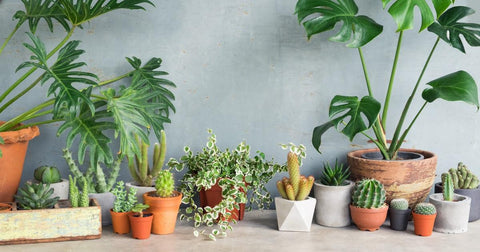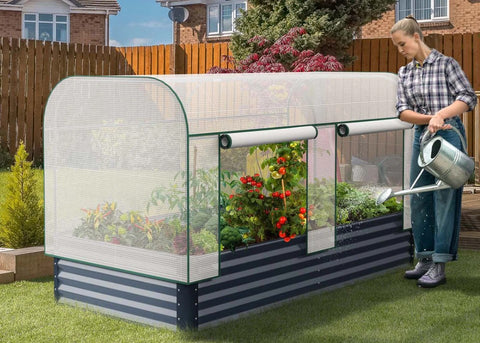In the realm of home gardening, the rise of innovative solutions has empowered enthusiasts to cultivate fresh, flavorful greens even in the tightest of spaces. One such ingenious solution is the use of raised bed salad boxes. These compact, elevated containers not only maximize space efficiency but also bring a touch of creativity to the art of growing greens. In this blog, we'll explore the benefits and techniques of cultivating salad greens in raised beds, unlocking the potential to savor the joy of a homegrown salad, no matter how limited your gardening space may be.The following content also has some reference value for raised garden beds.
The Advantages of Raised Bed Salad Boxes

- Space Efficiency:
One of the primary advantages of raised bed salad boxes is their ability to make the most of limited space. Whether you have a small balcony, patio, or even just a sunny windowsill, these compact containers can be strategically placed to optimize the use of available square footage.
- Improved Soil Quality:
Raised beds provide better control over soil quality. Gardeners can choose a nutrient-rich soil mix tailored to the specific needs of salad greens. This enhanced soil quality promotes healthy growth, providing a solid foundation for robust and flavorful harvests.
- Weed and Pest Control:
Elevated raised beds offer a natural barrier against weeds and certain pests. The raised structure helps prevent weed invasion, and the height deters ground-dwelling pests. This not only simplifies maintenance but also creates a more controlled environment for cultivating greens.
- Temperature Regulation:
Raised beds can help regulate soil temperature more effectively than traditional garden beds. In cooler climates, the elevated position allows the soil to warm up faster in the spring, while in warmer regions, it can help prevent overheating during hot summer days. This temperature control is particularly beneficial for salad greens, which often prefer mild growing conditions.
- Easy Accessibility:
The raised nature of these beds provides ergonomic benefits for gardeners. Tending to plants, watering, and harvesting become more accessible, reducing the strain on backs and knees. This feature is especially appealing for those who may have physical limitations or prefer a more comfortable gardening experience.
- Aesthetic Appeal:
Raised bed salad boxes can add a decorative element to any outdoor or indoor space. Available in various materials, shapes, and sizes, these containers can be chosen to complement the aesthetic of your surroundings, turning gardening into both a practical and visually pleasing endeavor.
- Customization and Rotation:
The modular nature of raised bed salad boxes allows for easy customization and rotation of crops. Gardeners can experiment with different varieties of salad greens, herbs, and companion plants, adjusting the layout to suit their preferences and maximize yields throughout the growing season.

Growing Greens in Raised Bed Salad Boxes
- Choosing the Right Container:
When selecting raised bed salad boxes, consider factors such as size, material, and drainage. Galvanized or composite materials are popular choices due to their durability and aesthetic appeal. Ensure that the containers have adequate drainage holes to prevent waterlogging, promoting a healthy root system.
- Selecting Salad Green Varieties:
Salad greens come in a diverse array of flavors, textures, and colors. Opt for a mix of varieties to create a visually appealing and flavorful salad. Consider including staples like lettuce, arugula, spinach, and kale, along with more unique options such as mizuna, radicchio, and microgreens.
- Preparing the Soil Mix:
Create a nutrient-rich soil mix by combining high-quality potting soil with organic compost. This blend provides the necessary nutrients for healthy plant development. Consider adding well-rotted manure or other organic amendments to further enhance soil fertility.
- Planting and Spacing:
Follow recommended spacing guidelines for each type of salad green to ensure proper airflow and prevent overcrowding. Planting in a staggered or offset pattern can optimize space utilization. Pay attention to the mature size of each variety and plan accordingly.
- Watering Routine:
Salad greens generally prefer consistently moist but well-draining soil. Water the raised bed salad boxes regularly, ensuring that the soil remains evenly moist. Use a watering can or gentle hose attachment to avoid disturbing delicate seedlings or compacted soil.
- Fertilizing:
Incorporate a balanced, organic fertilizer into the soil mix before planting, and supplement with additional feedings throughout the growing season. Liquid seaweed or fish emulsion are suitable choices for providing essential nutrients to salad greens.
- Managing Pests Naturally:
Keep an eye out for common pests such as aphids, snails, or caterpillars. Encourage natural predators like ladybugs or release beneficial insects to help control pest populations. Neem oil or insecticidal soap can be used for eco-friendly pest management.
- Harvesting Tips:
Harvest salad greens when they reach the desired size, typically before they bolt or become overly mature. Use clean, sharp scissors to cut leaves, allowing the plant to continue producing new growth. Harvesting regularly encourages a continuous supply of tender, flavorful greens.
- Succession Planting:
Extend the harvest season by practicing succession planting. Sow new seeds or transplant seedlings every few weeks to ensure a continuous supply of fresh salad greens. This approach maximizes the use of raised bed salad boxes and provides a steady stream of homegrown produce.
Conclusion:
Raised bed salad boxes offer a delightful solution for cultivating fresh, flavorful greens in even the most confined spaces. Their space efficiency, improved soil quality, and ergonomic advantages make them a valuable addition to any gardening repertoire. With careful planning, the right container, and a diverse selection of salad green varieties, you can transform limited spaces into vibrant, productive mini-gardens that not only nourish the body but also add a touch of nature's beauty to your surroundings. Embrace the joy of growing your salad, and savor the rewards of a homegrown harvest that elevates both your plate and your gardening experience.









